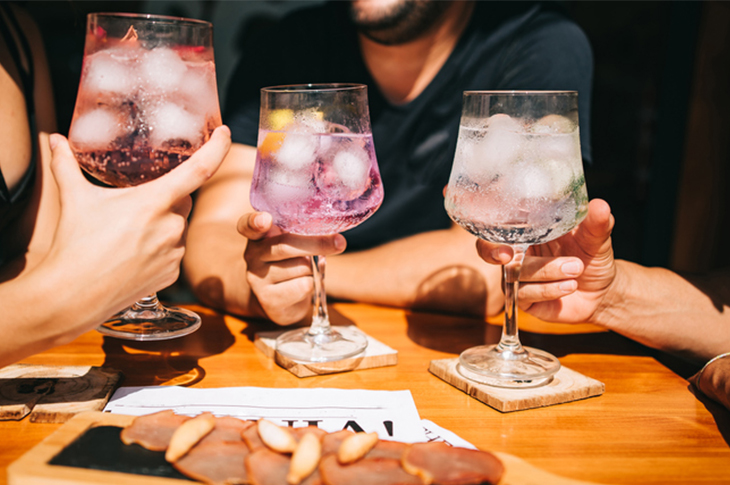
Many people think that, when it comes to alcohol use, it’s all-or-nothing; you either pursue full sobriety or you drink whatever and whenever you want. But it doesn’t have to be all-or-nothing. There’s a movement aimed at helping people want to better understand their relationship to alcohol and make healthier choices for themselves without necessarily giving up alcohol completely. It’s called the sober curious movement.
Let’s take a look at all things sober curious: what it is, how it differs from full sobriety or abstinence, and how (if you’re curious about it!) you can embrace the movement in your own life.
What is “sober curious”, and why is it having such a moment?
“The Sober Curious movement was launched by Ruby Warrington and her book, Sober Curious, in [late 2018],” says Elisa Peimer, LCSW, a therapist who has worked with a Sober Curious support group. “Sober Curious is a method of being mindful about drinking. People following it learn how to notice what triggers their drinking, what the act of drinking means to them, what needs it’s fulfilling, and how it’s adversely affecting their lives.”
The movement gained momentum quickly, in part because it allows people to explore living a more sober lifestyle without making the commitment to give up drinking entirely. “The movement encourages a sober (or more sober) lifestyle, but embraces and welcomes individuals who are not ready to quit alcohol entirely,” says Ian Andersen, co-founder of mindful drinking and moderation app Sunnyside.
The rise of the sober curious movement could also be viewed as an extension of health, wellness, and mindfulness in general becoming more mainstream. “As mindfulness in general has become more and more popular, being sober-curious feels like a natural extension of healthier lifestyle options like plant-based diets, yoga, and meditation,” says Molly Watts, author and host of The Alcohol Minimalist podcast.
Finally, the sober curious movement has gained quite the following on social media. And as more people and influencers have embraced the movement—and been willing to speak out about their choices around drinking less, or not at all—the movement has spread to more people. For example, “hashtags like #mindfuldrinking and #sobercurious are driving millions of views on social media,” says Andersen.
How is being sober curious different from being fully sober?
Being sober curious differs from traditional sobriety in a few ways—most notably that it doesn’t require abstinence from alcohol. Instead, it encourages people to, as the name suggests, get curious about their drinking—and aim to make better, more mindful choices around their alcohol use.
This allows people “to explore living a life without alcohol without having to fully commit to not drinking,” says Dr. Brooke Scheller, a Doctor of Clinical Nutrition who specializes in nutrition to support a sober or sober-curious journey.
“The focus is not on just abstinence, but on the choices we make when the stressors in our lives drive us to relieve them with alcohol rather than in more healthy ways,” says Peimer.
It also appeals to a wider audience. While full abstinence is generally recommended for people with an alcohol use disorder, the sober curious movement is a fit for anyone who wants to have a better relationship to alcohol—or who want to cut back their drinking for reasons outside of addiction or alcohol use disorder, like improving their health.
“Before this, sobriety was mostly reserved for those who identified as having a problem with alcohol,” says Scheller. “Over the last two years, people are now exploring a sober-curious lifestyle by cutting back or even fully eliminating alcohol for reasons that include physical and mental health reasons, to improve their careers, relationships, or even just because they’re sick of the hangover habit.”
“Sober curious offers a flexibility to acknowledge your use of alcohol might not be healthy without the rigidity of an all-or-nothing approach,” says Peimer.
Feeling curious? Tips on how to embrace the movement
Practice mindfulness when you reach for a drink. Mindfulness is the foundation of the sober curious movement.
“Sober curiosity is about mindfulness—looking at your actions in the moment and being honest with yourself,” says Peimer. “Notice what’s going on for you when you decide to drink.”
Before you take a drink, pause for a moment. Ask yourself “why am I taking this drink?”—and then, based on the answer, decide whether you want to move forward and have the drink. For example, when you stop to think about why you’re reaching for a drink, you may realize that it’s because you trying to manage challenging emotions, like boredom or anxiety—in which case you might opt to skip it in favor of a healthier coping mechanism, like calling a friend or going for a run.
Practicing mindfulness in the moments that you want or reach for a drink can help you better understand the motivations behind your drinking—and whether those motivations are in line with the kind of relationship you want to have with alcohol.
Get curious and ask yourself some deeper questions. In addition to bringing mindfulness to moments when you want to drink, being sober curious means…well, getting curious. Ask yourself some deeper questions about your relationship to alcohol. “Be thoughtful about what drinking means to you,” says Peimer. “Is it helping you create a narrative that’s appealing? Is it a reminder of happy times? Is it an indication that the weekend is starting?”
Understanding the reasons behind your drinking can help you make better, healthier choices around if and when to drink.
If you want to take things a step further, you may also want to ask yourself some questions about what it would be like to give up alcohol completely or consume less of it. “Ask yourself how your life would look without alcohol,” says Peimer.
If you want to see how drinking may impact your Sleep Score, check it after a night out with friends. You can also try comparing your Sleep Score on a night you haven’t imbibed with that of a night when you have. (Learn more about how to tap into Fitbit’s sleep tools, including your Sleep Score, here.)
Plan ahead. As mentioned, part of being sober curious is about being mindful when you reach for a drink. But while it’s important to be mindful in the moment, some are harder than others. And if there are moments you think it might be hard to say “no” to a drink—even if you want to? Plan ahead for them. “Try making a plan ahead of time for not drinking at an event that you normally would,” says Watts.
For example, do your Sunday catch-up brunches with your friends always end with you having one too many cocktails? Make a plan for what you’re going to drink instead (for example, a sparkling mocktail)—and for what you’re going to say.
As the old saying goes, “failing to plan is planning to fail”. Make sure to plan ahead for potentially challenging situations.
Try some non-alcoholic alternatives. If you want to change your relationship to alcohol—but also really enjoy the taste of beer, wine, or other alcoholic drinks? There’s good news.
“We’re…seeing a huge boom in the non-alcoholic beverage industry,” says Scheller. “While stores used to sell only one or two NA beers, we’re seeing a huge range of NA drinks in liquor stores, grocery stores, and even small markets—making it much easier to access alternatives to alcoholic beverages.”
There’s also been some serious improvements in the quality of non-alcoholic beverages—so you don’t have to sacrifice taste along with the buzz. “Many people are really surprised by how delicious some of the NA beverages are and you can have the mouth feel of your favorite drink without the negative aspects of alcohol,” says Watts.
Instead of having a drink every time you normally would (for example, with dinner or in the evening while you watch TV), “try to alternate your regular alcoholic drinks with an NA alternative,” says Watts.
And have fun with it! As mentioned, there are tons of NA options on the market—so choose beverages that seem interesting, tasty, and that you’ll be genuinely excited to try. “Having options that you can get excited about that are not alcohol is a great way to modify your habits,” says Andersen.
This information is for educational purposes only and is not intended as a substitute for medical diagnosis or treatment. You should not use this information to diagnose or treat a health problem or condition. Always check with your doctor before changing your diet, altering your sleep habits, taking supplements, or starting a new fitness routine.


